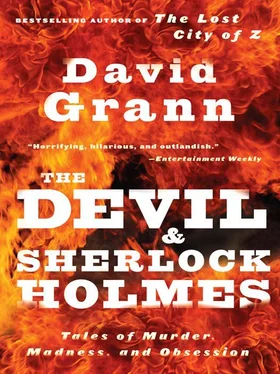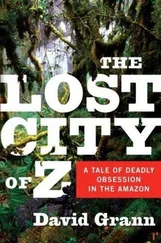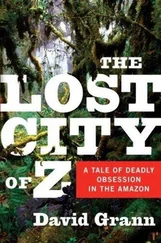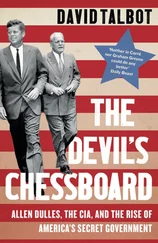David Grann - The Devil & Sherlock Holmes
Здесь есть возможность читать онлайн «David Grann - The Devil & Sherlock Holmes» весь текст электронной книги совершенно бесплатно (целиком полную версию без сокращений). В некоторых случаях можно слушать аудио, скачать через торрент в формате fb2 и присутствует краткое содержание. Жанр: Старинная литература, на английском языке. Описание произведения, (предисловие) а так же отзывы посетителей доступны на портале библиотеки ЛибКат.
- Название:The Devil & Sherlock Holmes
- Автор:
- Жанр:
- Год:неизвестен
- ISBN:нет данных
- Рейтинг книги:3 / 5. Голосов: 1
-
Избранное:Добавить в избранное
- Отзывы:
-
Ваша оценка:
- 60
- 1
- 2
- 3
- 4
- 5
The Devil & Sherlock Holmes: краткое содержание, описание и аннотация
Предлагаем к чтению аннотацию, описание, краткое содержание или предисловие (зависит от того, что написал сам автор книги «The Devil & Sherlock Holmes»). Если вы не нашли необходимую информацию о книге — напишите в комментариях, мы постараемся отыскать её.
comes this brilliant collection of true stories about people whose fixations propel them into unfathomable and often deadly circumstances.
Whether David Grann is investigating a mysterious murder, tracking a chameleon-like con artist, or hunting an elusive giant squid, he has proven to be one of the most gifted reporters and storytellers of his generation. In
, Grann takes the reader around the world, revealing a gallery of rogues and heroes who show that truth is indeed stranger than fiction.
The Devil & Sherlock Holmes — читать онлайн бесплатно полную книгу (весь текст) целиком
Ниже представлен текст книги, разбитый по страницам. Система сохранения места последней прочитанной страницы, позволяет с удобством читать онлайн бесплатно книгу «The Devil & Sherlock Holmes», без необходимости каждый раз заново искать на чём Вы остановились. Поставьте закладку, и сможете в любой момент перейти на страницу, на которой закончили чтение.
Интервал:
Закладка:
After six months, the investigation was dropped, because of “an inability to find the perpetrator or perpetrators,” as the prosecutor put it in his report. Janiszewski’s family hung a cross on an oak tree near where the body was found—one of the few reminders of what the Polish press dubbed “the perfect crime.”
One afternoon in the fall of 2003, Jacek Wroblewski, a thirty-eight-year-old detective in the Wroclaw police department, unlocked the safe in his office, where he stored his files, and removed a folder marked “Janiszewski.” It was getting late, and most members of the department would soon be heading home, their thick wooden doors clapping shut, one after the other, in the long stone corridor of the fortress-like building, which the Germans had built in the early twentieth century, when Wroclaw was still part of Germany. (The building has underground tunnels leading to the jail and the courthouse, across the street.) Wroblewski, who preferred to work late at night, kept by his desk a coffeepot and a small refrigerator; that was about all he could squeeze into the cell-like room, which was decorated with wall-sized maps of Poland and with calendars of scantily clad women, which he took down when he had official visitors.
The Janiszewski case was three years old, and had been handed over to Wroblewski’s unit by the local police who had conducted the original investigation. The unsolved murder was the coldest of cold cases, and Wroblewski was drawn to it. He was a tall, lumbering man with a pink, fleshy face and a burgeoning paunch. He wore ordinary slacks and a shirt to work, instead of a uniform, and there was a simplicity to his appearance, which he used to his advantage: people trusted him because they thought that they had no reason to fear him. Even his superiors joked that his cases must somehow solve themselves. “Jacek” is “Jack” in English, and wróbel means “sparrow,” and so his colleagues called him Jack Sparrow—the name of the Johnny Depp character in “Pirates of the Caribbean.” Wroblewski liked to say in response, “I’m more of an eagle.”
After Wroblewski graduated from high school, in 1984, he began searching for his “purpose in life,” as he put it, working variously as a municipal clerk, a locksmith, a soldier, an aircraft mechanic, and, in defiance of the Communist government, a union organizer allied with Solidarity. In 1994, five years after the Communist regime collapsed, he joined the newly refashioned police force. Salaries for police officers in Poland were, and remain, dismal—a rookie earns only a few thousand dollars a year—and Wroblewski had a wife and two children to support. Still, he had finally found a position that suited him. A man with a stark Catholic vision of good and evil, he relished chasing criminals, and after putting away his first murderer he hung a pair of goat horns on his office wall, to symbolize the capture of his prey. During his few free hours, he studied psychology at a local university: he wanted to understand the criminal mind.
Wroblewski had heard about the murder of Janiszewski, but he was unfamiliar with the details, and he sat down at his desk to review the file. He knew that, in cold cases, the key to solving the crime is often an overlooked clue buried in the original file. He studied the pathologist’s report and the photographs of the crime scene. The level of brutality, Wroblewski thought, suggested that the perpetrator, or perpetrators, had a deep grievance against Janiszewski. Moreover, the virtual absence of clothing on Janiszewski’s battered body indicated that he had been stripped, in an attempt to humiliate him. (There was no evidence of sexual abuse.) According to Janiszewski’s wife, her husband always carried credit cards, but they had not been used after the crime—another indication that this was no mere robbery.
Wroblewski read the various statements that had been given to the local police. The most revealing was from Janiszewski’s mother, who had worked as a bookkeeper in his advertising firm. On the day that her son disappeared, she stated, a man had called the office at around 9:30 A.M., looking for him. The caller made an urgent request. “Could you make three signs, quite big ones, and the third one as big as a billboard?” he asked. When she inquired further, he said, “I will not talk to you about this,” demanding again to speak to her son. She explained that he was out of the office, but she gave the caller Janiszewski’s cell-phone number. The man hung up. He had not identified himself, and Janiszewski’s mother had not recognized his voice, though she thought that he sounded “professional.” During the conversation, she had heard noise in the background, a dull roar. Later, when her son showed up at the office, she asked him if the customer had called, and Janiszewski replied that they had arranged to meet that afternoon. According to a receptionist in the building, who was the last known person to see Janiszewski alive, he departed the office at around four o’clock. He left his car, a Peugeot, in the parking lot, which his family said was very unusual: although he often met with customers away from the office, he habitually took his car.
Investigators, upon checking phone records, discovered that the call to Janiszewski’s office had come from a phone booth down the street—this explained the background noise, Wroblewski thought. Records also indicated that, less than a minute after the call ended, someone at the same public phone had rung Janiszewski’s cell phone. Though the calls were suspicious, Wroblewski could not be certain that the caller was a perpetrator, just as he could not yet say how many assailants were involved in the crime. Janiszewski was more than six feet tall and weighed some two hundred pounds, and tying him up and disposing of his body may have required accomplices. The receptionist reported that when Janiszewski left the office she had seen two men seemingly trailing him, though she could not describe them in any detail. Whoever was behind the abduction, Wroblewski thought, had been extremely organized and shrewd. The mastermind—Wroblewski assumed it was a man, based on the caller’s voice—must have studied Janiszewski’s business routine and known how to lure him out of his office and, possibly, into a car.
Wroblewski pored over the materials, trying to find something more, yet he remained stymied. After several hours, he locked the file in his safe, but over the next several days and nights he took it out again and again. At one point, he realized that Janiszewski’s cell phone had never been found. Wroblewski decided to see if the phone could be traced—an unlikely possibility. Poland lagged behind other European countries in technological development, and its financially strapped police force was only beginning to adopt more sophisticated methods of tracking cellular and computer communications. Nevertheless, Wroblewski had taken a keen interest in these new techniques, and he began an elaborate search, with the help of the department’s recently hired telecommunications specialist. Although Janiszewski’s telephone number had not been used since his disappearance, Wroblewski knew that cell phones often bear a serial number from the manufacturer, and his men contacted Janiszewski’s wife, who provided a receipt containing this information. To Wroblewski’s astonishment, he and his colleague soon found a match: a cell phone with the same serial number had been sold on Allegro, an Internet auction site, four days after Janiszewski disappeared. The seller had logged in as ChrisB[7], who, investigators learned, was a thirty-year-old Polish intellectual named Krystian Bala.
It seemed inconceivable that a murderer who had orchestrated such a well-planned crime would have sold the victim’s cell phone on an Internet auction site. Bala, Wroblewski realized, could have obtained it from someone else, or purchased it at a pawnshop, or even found it on the street. Bala had since moved abroad, and could not be easily reached, but as Wroblewski checked into his background he discovered that he had recently published a novel called “Amok.” Wroblewski obtained a copy, which had on the cover a surreal image of a goat—an ancient symbol of the Devil. Like the works of the French novelist Michel Houellebecq, the book is sadistic, pornographic, and creepy. The main character, who narrates the story, is a bored Polish intellectual who, when not musing about philosophy, is drinking and having sex with women.
Читать дальшеИнтервал:
Закладка:
Похожие книги на «The Devil & Sherlock Holmes»
Представляем Вашему вниманию похожие книги на «The Devil & Sherlock Holmes» списком для выбора. Мы отобрали схожую по названию и смыслу литературу в надежде предоставить читателям больше вариантов отыскать новые, интересные, ещё непрочитанные произведения.
Обсуждение, отзывы о книге «The Devil & Sherlock Holmes» и просто собственные мнения читателей. Оставьте ваши комментарии, напишите, что Вы думаете о произведении, его смысле или главных героях. Укажите что конкретно понравилось, а что нет, и почему Вы так считаете.











